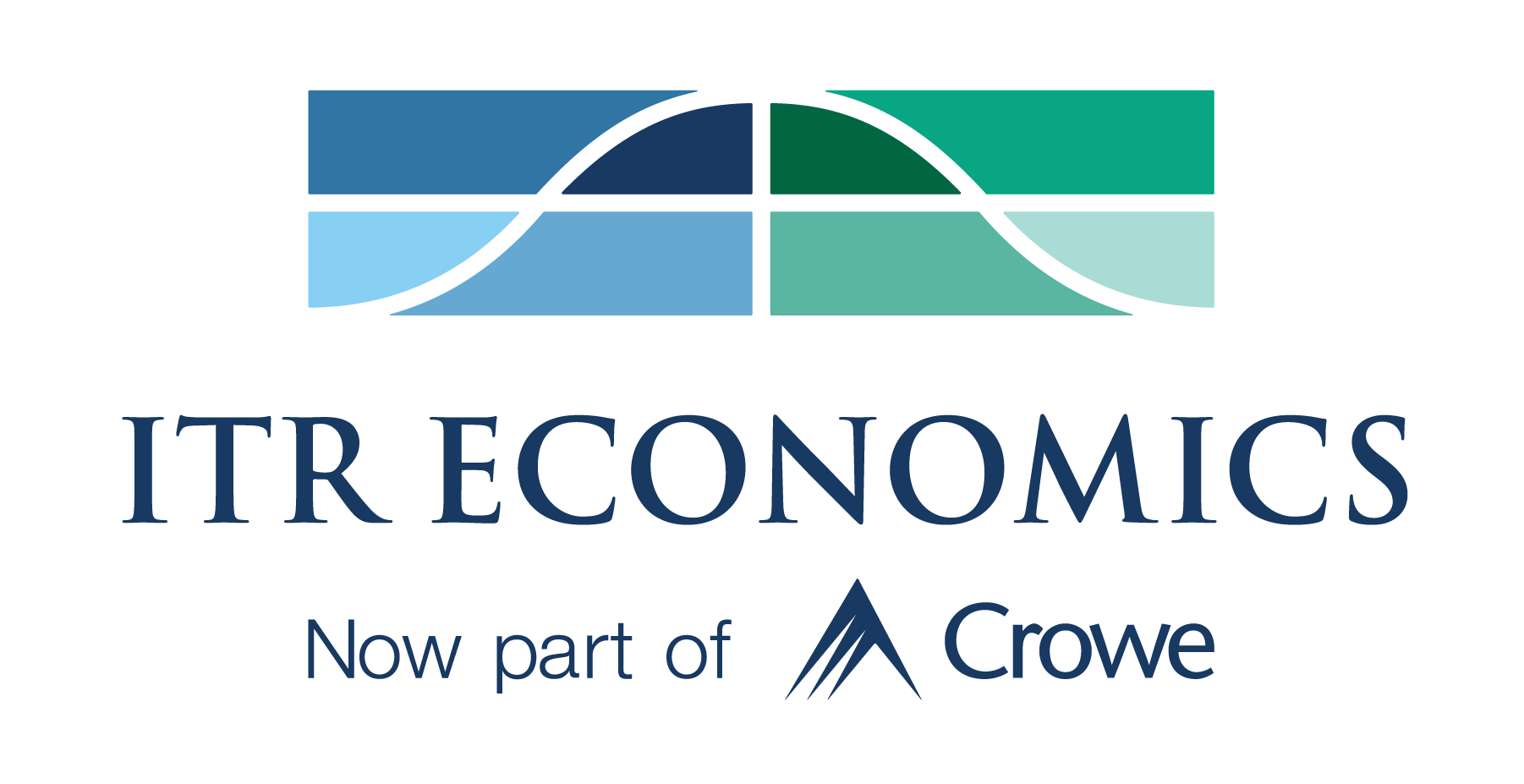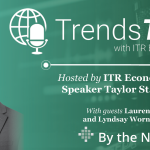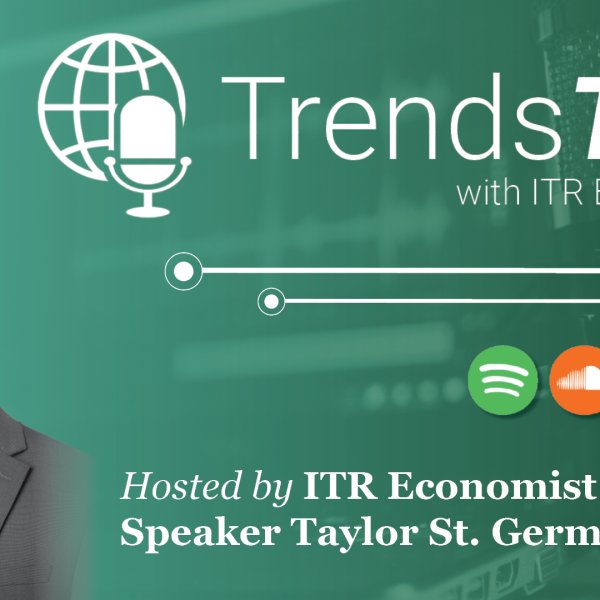- Mon - Fri: 8:30 - 5:00
- +1-603-796-2500
- ITR@itreconomics.com
June 3, 2024
- Home
- portfolio
- TrendsTalk
- June 3, 2024
with Taylor St. Germain
REVISITING RETAIL SALES AND THE CONSUMER
This week on TrendsTalk, host Taylor St. Germain revisits ITR Economics’ Retail Sales forecast and puts a spotlight on consumers. How will the positives and negatives consumers face impact Retail Sales this year and into 2025? Tune in to find out!

MEET YOUR HOST
Taylor St. Germain
As an experienced economist, Taylor St. Germain provides consulting services for small businesses, trade associations, and Fortune 500 companies across a spectrum of industries. His dynamic personality and extensive knowledge of economic trends and their business relevance are highly valued by clients and colleagues alike.
“Join me on the TrendsTalk podcast to explore the world of economics. Episodes offer insightful discussion and expert interviews. We cover relevant economic concepts in an accessible way. Whether you are a curious layperson or an industry professional, TrendsTalk is your go-to source for thought-provoking analysis and a deeper understanding of the economic forces shaping our world.”
Key Episode Takeaways
- 0:21 – Revision to our Retail Sales forecast due to revisions from the Census Bureau
- 1:29 – Reviewing the 12MMT data for Retail Sales in the US
- 2:27 – Steady growth in Retail Sales, just at a slower pace
- 3:23 – Retail Sales expectations for 2025
- 4:38 – Highlighting the positives and negatives for the consumer
- 4:48 – Looking at consumer debt levels
- 5:46 – Looking at household debt
- 6:29 – Reviewing real personal income (inflation-adjusted wages)
- 7:11 – Percentage of consumers making the minimum payment on credit card accounts
- 10:12 – Summary and conclusion
The below transcript is a literal translation of the podcast audio that has been machine generated by Rev.
Hi, everyone. My name is Taylor St. Germain with ITR Economics, and welcome to this edition of TrendsTalk. We at ITR are your unbiased and apolitical source of economic intelligence. And today I wanted to visit retail sales and the consumer. We issued a revision to our retail sales forecast recently. It was a mild revision, and it happens as a result of revisions from the Census Bureau. Every year, the Census Bureau issues a historical data revision, and as a result, we have to revisit our forecast. So I wanted to give you the updated perspective on retail sales, but of course the consumer has a lot to do with retail sales. So after I share with you our updated retail sales outlook, we’ll talk about good news from the consumer and then some worries that we might have related to the consumer. As we sit here today, we refer to them at ITR as upside and downside risks to the forecast.
And of course, we always want to be transparent with all of you in terms of what we’re looking at behind the scenes. So first of all, let’s detail where retail says, “Retail sales is in the business cycle today.” And then we’ll talk about our forecast moving forward. Then we’ll get into some of those underlying consumer trends. I wanted to first start off by highlighting as we sit here today, the most recent data point that we have details, the 12-month moving total for retail sales at $8.385 trillion. That is a record high in retail sales here in the US. But of course, as you know from listening to TrendsTalk and following ITR, we focus on growth rates as well because the growth rates let us know where we are in the economic business cycle. And retail sales has been slowing down in terms of the annual growth rate or 12/12 rate-of-change really since February of 2022. But it’s slowing growth. It’s not contraction, it’s not decline, it’s growth that’s occurring at a slower pace. So ever since that first quarter of 2022, we have seen retail sales slowing down, but still positive.
As we sit here today, the annual growth rate, again, that 12/12 rate-of-change is up 3.3% compared to the same period one year ago. So we’re seeing some nice steady growth in terms of retail sales even though it’s at a slower pace. In terms of where we see retail sales moving in the future, no recession predicted for retail sales. The consumer overall is holding up quite strong, especially the upper end of income earners here in the United States. So let me share forecast values with you in 2024. We do expect retail sales to continue to slow down from the 3.3% we see here today to finishing the year up 3.1%. So that’s comparing the full year of ’24 to ’23 and expecting retail sales to be up 3.1% or $8.55 trillion.
As we fast forward to ’25, we expect retail sales to accelerate do in part to consumer strength, but also to persistent inflation. As I should mention here, retail sales is a dollar denominated series, so inflation will have an impact, but our growth rate for ’25 compared to ’24 is 4.6%, and that’s 8.945 trillion. And then in ’26, we would expect retail sales to once again slow, but again, not contract finishing ’26 up 2.4% compared to 2025. So what I’m sharing with you here is we’re projecting three consecutive years of growth in US total retail sales. Again, it’s important to acknowledge that that comes at a different pace depending on which year we’re looking at, but it’s nothing but growth for at least the next three years. And I think that’s very good news, especially for those of you in the retail space. Those of you whose businesses and products are really related to the consumer and the strength and the consumer. I think you’ll continue to see some very strong growth over the coming years.
But again, let’s highlight some positives and some negatives related to the consumer that could impact retail sales. I’m in a good mood today. So let’s start off with the positives. I wanted to start with looking at levels of debt. We’ve looked at levels of debt on previous episodes, and I wanted to share that when we look at household debt as a percentage of median annual earnings and credit card debt as a percentage of median annual earnings, those values of relative little concern is what I really should say here. If you look at credit card debt, again as a percentage of median annual earnings, it’s up 14.4% right now. That’s the percentage, I shouldn’t say it’s up. I should say the percentage is 14.4%, and that is still below the pre-pandemic high of 15.4%.
So yes, we have seen a little bit of a rise in credit card debt, but again, compared to history and compared to trends before the pandemic, we’re still below. So it’s something we’re watching, but not something we’re worrying about at this point in time. When we look at household debt, that ratio, again, household debt per capita as a percentage of median annual earnings is at 109.4% percent. I know that sounds high, but it’s below the 111% that we saw before the pandemic. So in terms of overall debt burdens, and again, in terms of looking at this ratio as it relates to earnings, these ratios are still relatively low or relatively muted compared to what we’ve seen throughout history. So that’s good news. That’s what I’m saying is in terms of overall debt, credit card, household debt, not seeing any trends at this point in time that are overly concerning to us.
Another good news trend related to the consumer is looking at real personal income. So this is inflation adjusted wages. We want to remove that inflation piece. We want to look at real wages, and those are still rising as we sit here today and have been rising really as we look throughout the past year and a half, two years. So consumer incomes are rising, consumer debt burdens are relatively low. That’s all-good news for some growth in retail sales moving forward and growth in GDP for that matter as the consumer makes up two-thirds of GDP. But let me share some of what I’d call the downside risks to our forecasts. Again, these are risks at this time, not something that we’re building into our forecast as an overt concern, but it’s still a risk that I want to make you aware of. And that risk is the share of consumer credit card accounts making the minimum payment.
If you look at the three-month moving average through the end of 2023, that number is 10.7%. So 10.7% of consumers are making the minimum payment. If we look at the peak before the pandemic occurred in December 2019, that value was at 10.3%. So we’re about 0.4% higher in terms of the share of consumers making the minimum payment on their credit cards. And I think this does speak to the fact that the higher income earners here in the United States have a relatively low share of debt and relatively low minimum payment. But if you look at some of the bottom half of income earners, that’s where some of the concern is here today. So it’s something to be aware of as you’re planning for ’24 and ’25, looking at some of those products that you have that might be lower priced, they might be more advantageous to some of these consumers, especially those that are finding themselves making more of those minimum payments on their credit card.
So I’d say again, the number of folks making minimum payments is a slight concern. It’s not something that suggests dire situations for retail sales, but it is something that we’re monitoring closely given we’re above the pre-pandemic peak. Another concern I would share is the fact that the savings balance has really leveled out. Again, we deflate the savings balance, so we really look at deflated trends. And we’re below the pre-pandemic peak in terms of inflation, or I should say we’re below the pandemic peak, not the pre-pandemic peak, but the pandemic peak in terms of where our savings balances are. And that makes sense. Because during the pandemic, many of us were sheltered in place, we didn’t have much to spend money on, so we saw savings accounts swell.
So it’s not surprising that we have slightly less savings today than we did during the pandemic, but continuing to see that savings balance really flattening is something that we have to keep an eye on. Now, flat’s not the end of the world, but if we see a downward trend, that’s where things can become a bit more concerning. So overall, these two risks are something that we’re monitoring. Again, they’re not suggesting we need to change our forecast for retail sales or for GDP at this point in time to be more pessimistic. But it’s worth noting, it’s worth watching, and it’s worth considering when you’re planning as we move forward.
So overall, three consecutive years of growth in retail sales. Debt burdens are still relatively low and in control. Consumer incomes are rising, but let’s keep our eyes on minimum payments on credit cards and on the savings balance. Again, I think this is a really important time in the cycle. If you correlate to US total retail sales, it’s taking the steps to invest to be prepared to take on all of this demand that’s coming your way. But it’s important to segment retail sales and look at the different income brackets and understand which products, especially depending on the price of your different product lines, might perform better during slowing growth times of retail sales, like we’ll likely see for the remainder of this year.
We’ll continue to keep you updated on the consumer, and if you’re curious to find more frequent information on our retail sales forecast, you can subscribe to our trends report. We have a whole page detailing this three-year retail sales forecast. I hope you found this information helpful. Again, I’m Taylor St. Germain with ITR Economics on TrendsTalk. And please like and subscribe to TrendsTalk wherever you listen to your podcasts, and I’m looking forward to seeing you on the next one. Take care for now.







